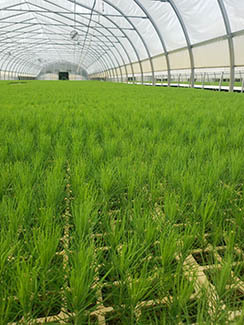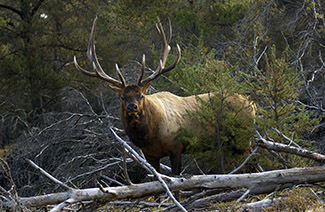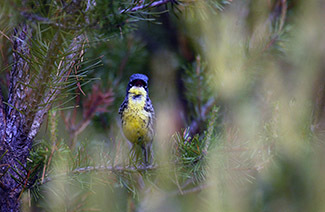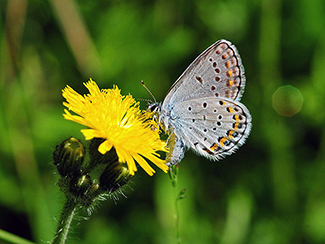Getting into green spaces
By RACHEL COALE
Michigan Department of Natural Resources
“Green is the prime color of the world, and that from which its loveliness arises” - Pedro Calderon de la Barca, 1600s' Spanish poet

People who enjoy the outdoors have extolled the benefits of being close to nature since they first laced up hiking boots for adventure instead of work. A growing body of research on human health and happiness is confirming how good it is for us to connect with nature.
Fortunately, Michigan has plenty of what is often called “green space.” With 20 million acres of forest land, more than half the state is shaded by leafy canopy.
What is a green space?
A green space is an undeveloped area with natural features like trees and plants – it can be as small as a quarter-acre “pocket park” in the city or as expansive as the more than 100,000 acres making up the Pigeon River Country State Forest northeast of Gaylord, which conservationist P.S. Lovejoy called “the Big Wild.”
No matter the size, these places matter. They contribute wildlife habitat and benefit the health of the environment and the people who enjoy them.
“There’s an array of mental, physical and social benefits that we derive from green spaces,” said Kevin Sayers, Michigan Department of Natural Resources Urban and Community Forestry Program manager. “People desire and understand the need for having trees, forests and other types of nature nearby.”
In Michigan, our green spaces are diverse. We can visit old-growth forests, flowering prairies, windswept dunes and rich wetlands. But you don’t have to go “up north” or far away from home to enjoy green spaces – local parks, gardens, sports fields and trails count too. Natural areas of all kinds support community health and wellness.
Green spaces are good for us
Just looking at trees has benefits — really. Research shows that office workers with a view of trees have lower stress levels that those who don’t. According to an Exeter University study, even an office plant provides some mental health benefits.
Similar research shared by the Smithsonian Institution shows that children who grow up in neighborhoods with greenery have a lower risk of developing psychiatric disorders, even after adjusting for other factors.
|

The reasons why are still being investigated, but researchers theorize that green spaces help us recover from stresses caused by the bustle and friction of work and school environments. Just like wildlife, people also need the right kind of “habitat” to be happy and healthy.
In addition to the peace of mind they seem to bring, green spaces benefit communities by creating places to be active and play. They also raise property values through their natural beauty and provide basic ecological functions like soaking up and cleaning stormwater.
Having nature in our lives, even in small amounts, has value. Instead of thinking of natural spaces as places to visit only on weekends, it might be helpful to bring some into our lives each day.
We need green
The most beneficial and recognizable green space is one with trees. We need trees for every aspect of our lives. Caring for natural resources helps ensure that we will have healthy forests for clean air and water and renewable materials for homes, health products and clothing.
For each tree harvested in Michigan, two are grown in its place. Michigan’s forests are certified sustainable by two independent organizations, the Sustainable Forestry Initiative and the Forest Stewardship Council.
Their logos on product labels let consumers know that the forests used to make these products were managed responsibly. Auditors annually visit the state forests for a checkup to make sure forestry practices are up to certification standards.
|

Forests also cultivate another type of green – the economic boost that comes from a thriving industry. Michigan’s forestry industry contributes $21 billion annually to our state’s economy and supports nearly 100,000 jobs.
How we care for forests – the biggest green spaces
The DNR forestry staff manages the largest state forest system in the lower 48 states.
Responsible forest management, using tools like prescribed burns, tree planting and strategic cutting, supports healthy habitats for wildlife.
Although at first it may seem counterproductive to maintaining green space, cutting trees creates specific types of habitat, replaces trees that have reached their lifespan and removes trees damaged by insects or disease.
For example, through selective cutting, clear-cutting and planting anew, foresters have ensured that Michigan’s elk herd has the right mix of deep forest and open-space habitat to thrive.
“Michigan’s elk herd lives in a working forest, and commercial timber sales are the primary means we use to achieve wildlife and timber objectives,” said Scott Whitcomb, the DNR’s senior advisor for wildlife and public lands. “The young forests that grow back after logging are used by many wildlife species including elk, ruffed grouse and golden-winged warblers.”
One of the best examples of the benefits of forest management is the dramatic recovery of the Kirtland’s warbler.
After habitat decline and competition from brown-headed cowbirds landed the small songbird on the endangered species list in the 1960s, forest managers from the DNR and the U.S. Forest Service worked together to restore the warbler’s favored habitat.
|

Old trees were cut and replaced with wavy lines of young jack pines for the warblers to nest in. The trees will continue to be replaced as they grow too large for suitable nesting habitat.
The Kirtland’s warbler population, which is situated largely in Michigan, has grown from a low of 400 a few decades ago to about 4,000. In October, birdwatchers and conservationists celebrated the warbler’s removal from the endangered species list.
Now, the warbler is instead being added to the life lists of birders from across the globe who can thank foresters and wildlife biologists for the opportunity.
"Perhaps one of the best components of the Kirtland’s warbler conservation success story is how addressing endangerment was not done in a siloed fashion — it was done collaboratively and with the essential elements and guidelines of ecology in mind,” said Michigan Audubon Executive Director Heather Good. “The degree to which forest management priorities were dedicated to responding to, supporting and sustaining the recovery of the Kirtland’s warbler is truly remarkable and absolutely necessary to seeing the recovery that we’ve seen with this bird.”
Like tree cutting, prescribed burning may seem destructive, but these fires mimic natural processes essential for new growth. Within a year of a burn, scorched ground blooms with new life and becomes a prime area for mushroom hunting and wildlife watching.
Burns regenerate prairie plants, remove invasive species and provide essential assistance for jack pine trees, whose pinecones only open and release seeds in extreme heat.
|

The thumbnail-sized, endangered Karner blue butterfly also benefits from prescribed burns through its relationship with the wild lupine, a spiky, fire-loving prairie plant related to peas. The butterflies lay their eggs on or near lupine plants, and their caterpillars feed only on lupine leaves and flowers.
Trained DNR staff members conduct prescribed burns on about 7,000 acres of state land annually.
In addition to its work in state forests, the DNR is also investing in urban green spaces.
Tree-planting grants and partnerships with organizations like the Arbor Day Foundation and ReLeaf Michigan have helped increase the number of trees planted and maintained in communities throughout the state.
Education efforts also are helping communities keep their green spaces resilient and healthy. In 2017, a prescribed burn was conducted right on Detroit’s riverfront, renewing habitat at Milliken State Park and showcasing the ways we can bring nature close to home.
Responsible forest management is ensuring that people and wildlife can enjoy the benefits of nature now and into the future.
Explore parks, forests, trails and other green spaces managed by the DNR under “Places to Go” on the DNR website at Michigan.gov/DNR. Take an online tour of Michigan’s state forests, and learn about forest recreation opportunities, at Michigan.gov/StateForests.
|
Check out previous Showcasing the DNR stories in our archive at Michigan.gov/DNRStories. To subscribe to upcoming Showcasing articles, sign up for free email delivery at Michigan.gov/DNR.
/Note to editors: Contact: John Pepin, Showcasing the DNR series editor, 906-226-1352. Accompanying photos and a text-only version of this story are available below for download. Caption information follows. Credit Michigan Department of Natural Resources, unless otherwise noted.
Text-only version of this story.
Autumn: A forest in Clare County decked out in autumn splendor. (Michigan Department of Transportation photo)
Birdwatcher: A birdwatcher looks to spot a Kirtland’s warbler on an outing near Grayling.
Elk: Effective forest management provides habitat helpful to sustaining Michigan’s elk herd.
Karner: A Karner blue butterfly lights on a yellow hawkweed bloom. (U.S. Fish and Wildlife Service photo)
Kids: There are many health benefits associated with spending time in places where trees and green space are found.
Lupine: Wild lupine are attractive flowers important to wildlife species. (U.S. Fish and Wildlife Service photo)
Pocket: The Michigan Department of Natural Resources’ Pocket Park provides a green space on the Upper Peninsula State Fairgrounds in Delta County.
Tree: A tree farm in Brighton shows the beginnings of forests for tomorrow.
Urban: Green spaces are an important part of urban settings, as shown here in Detroit. (Michigan Department of Transportation photo)
Warbler: A male Kirtland’s warbler is shown perched in a jack pine tree./
|